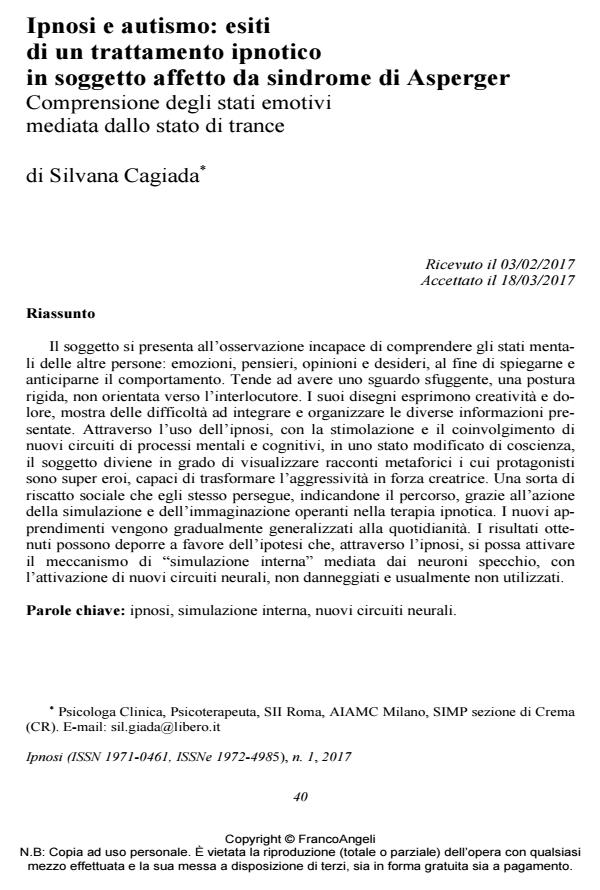Hypnosis and autism: the results of treatment using hypnosis with a patient suffering from Asperger’s syndrome. Understanding emotional states through the use of hypnotic trance
Journal title IPNOSI
Author/s Silvana Cagiada
Publishing Year 2017 Issue 2017/1
Language Italian Pages 12 P. 40-51 File size 368 KB
DOI 10.3280/IPN2017-001002
DOI is like a bar code for intellectual property: to have more infomation
click here
Below, you can see the article first page
If you want to buy this article in PDF format, you can do it, following the instructions to buy download credits

FrancoAngeli is member of Publishers International Linking Association, Inc (PILA), a not-for-profit association which run the CrossRef service enabling links to and from online scholarly content.
Hypnosis and autism: results of hypnotic treatment in a subject with Asper-ger’s syndrome. Understanding of emotive states mediated by a state of trance. The subject, observed as being incapable of understanding the mental state of other people’s emotions, thoughts, opinions and desires and also of being incapable of explaining or anticipating the behavior of others. The subject tends to have an absent gaze, rigid posture and being unable to face another person. Drawings express creativity and pain and show the difficulties experienced in the integration and organization of information presented. Through the use of hypnosis, with the stimulation and involvement of new circuits of mental and cognitive processes in a state of modified consciousness, the subject became capable of visualizing metaphoric stories with superheroes as the principal characters. This enabled him to transform aggression into a creative force. It was a sort of social redemption that he was able to follow, thanks to the acts of simulation and imagination that function during hypnosis. The new skills he has learned gradually become generalized into daily life. The results obtained give evidence in favor of a hypothesis that, through hypnosis, it is possible to activate the "internal simulation" mechanism mediated by the mirror neurons with the activation of new neuronal circuits which have not been damaged and are not usually used.
Keywords: Hypnosis, internal simulation, new neuronal circuits.
- Autoipnosi: strumento per il mantenimento dell'omeostasi per la prevenzione della malattia attraverso l'attivazione delle risorse interiori Silvana Cagiada, Rita Pizzi, in IPNOSI 2/2020 pp.25
DOI: 10.3280/IPN2020-002002
Silvana Cagiada, Ipnosi e autismo: esiti di un trattamento ipnotico in soggetto affetto da sindrome di Asperger - Comprensione degli stati emotivi mediata dallo stato di trance in "IPNOSI" 1/2017, pp 40-51, DOI: 10.3280/IPN2017-001002